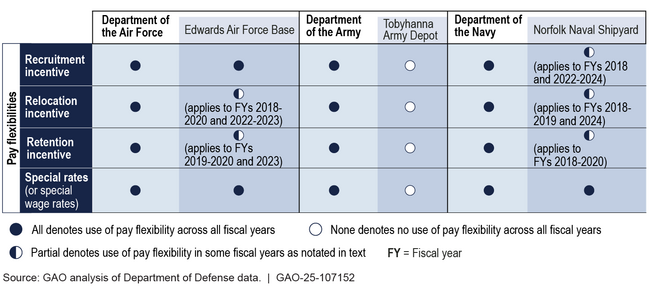Defense Workforce: Efforts to Address Challenges in Recruiting and Retaining Federal Wage System Employees
Fast Facts
The Department of Defense relies on its federal blue-collar workforce to maintain and repair weapons, aircraft, electronics, and other equipment. DOD has faced longstanding recruitment and retention challenges for these positions. We found that a pay cap set by Congress on wage rates for this workforce may have contributed to these challenges.
To offset these challenges, the DOD installations we reviewed used recruitment, relocation, and retention incentives to attract skilled workers. But one installation, Edwards Air Force Base, did not set measurable targets to determine the results of its efforts.
Our recommendation addresses this.
Aircraft Mechanic

Aircraft mechanic conducting maintenance or repair work
Highlights
What GAO Found
The underlying principles of the Federal Wage System (FWS) are to set hourly pay rates for federal blue-collar workers in line with local prevailing (or market) rates and provide equal pay for substantially equal work. However, these principles have not been met because of several challenges with the FWS. These challenges include:
- effect of the pay adjustment cap on final FWS wage rates and wage schedules;
- inexact match between local wage survey job descriptions used to compare federal FWS and private sector occupations; and
- amount of private sector wage data collected for local wage surveys.
In addition, officials from most selected Department of Defense (DOD) services—Air Force, Army, and Navy—and installations—Edwards Air Force Base, Tobyhanna Army Depot, and Norfolk Naval Shipyard—reported challenges with recruiting and retaining FWS employees, such as competition with the private sector for skilled labor and the lengthy federal onboarding process.
All selected DOD services and installations took actions to address recruitment and retention challenges, including the use of various pay flexibilities, for certain FWS employees.
Selected Services' and Installations' Use of Pay Flexibilities to Recruit and Retain Federal Wage System Employees, Fiscal Years 2018–2024

Note: For more details, see figure 5 in GAO-25-107152.
GAO found the selected installations have or are developing goals for the FWS workforce. Norfolk Naval Shipyard and Tobyhanna Army Depot used measurable targets for determining their FWS workload needs. However, Edwards Air Force Base did not have measurable targets for recruiting and retaining its FWS workforce. Establishing measurable targets will help Edwards Air Force Base better assess the results of specific actions and strategies taken to improve FWS recruitment and retention and effectively manage its workforce to meet its mission.
Why GAO Did This Study
DOD relies on its blue-collar workforce to perform and support a variety of work. GAO's prior work found that DOD has faced long-standing workforce challenges in competing with the private sector and other federal agencies for skilled workers.
The Joint Explanatory Statement for the James M. Inhofe National Defense Authorization Act for Fiscal Year 2023 includes a provision for GAO to report on the FWS. This report examines (1) challenges in administering the FWS that may affect recruitment and retention at selected DOD services and installations, and (2) the extent to which selected DOD services and installations have taken actions to address FWS recruitment and retention challenges.
GAO selected the services and installations based on factors, such as the size of the FWS workforce, the presence of different types of FWS employees, and geographic dispersion. GAO analyzed DOD data from fiscal years 2018 through 2024 to identify workforce trends; analyzed agency documents; and interviewed agency and union officials. GAO conducted site visits to Edwards Air Force Base, Tobyhanna Army Depot, and Norfolk Naval Shipyard. GAO compared the services' and installations' use of goals and targets for the FWS workforce to GAO's performance management practices.
Recommendations
GAO recommends that the Secretary of the Air Force ensure that Edwards Air Force Base develops and documents staffing targets for its FWS workforce. DOD and Air Force agreed with the recommendation.
Recommendations for Executive Action
| Agency Affected | Recommendation | Status |
|---|---|---|
| Department of the Air Force | The Secretary of the Air Force should ensure that the Commander of Edwards Air Force Base develops measurable staffing targets for Edwards's FWS workforce and documents these targets in a civilian workforce plan or other documents used to help manage Edwards's FWS AF workforce. (Recommendation 1) |
When we confirm what actions the agency has taken in response to this recommendation, we will provide updated information.
|
